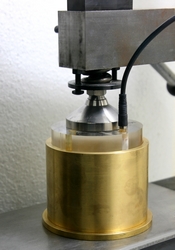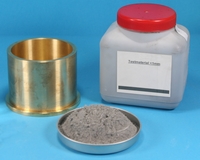Thermal Conductivity of Fragments and Powder
Loose materials like fragments or powder consist of the solid material and the pore filling (air). As the thermal conductivity of air is extremely low, the thermal conductivity of loose materials depends largely on the ratio of solid material to pore volume. For loose materials, the pore volume is not well defined but may change significantly when shaking the sample. Hence direct thermal conductivity tests are impossible.
![arrow]() Measuring Principle
Measuring Principle
 To describe the thermal properties of loose materials, we use the matrix thermal conductivity - which is the value that a non-porous solid block formed from the grain material would have. To determine this value, the air between the grains is replaced with a fluid of known thermal conductivity, then the mixture is measured. The matrix thermal conductivity is calculated from the test result, the amounts of solid and fluid in the mixture, and the known thermal conductivity of the fluid.
To describe the thermal properties of loose materials, we use the matrix thermal conductivity - which is the value that a non-porous solid block formed from the grain material would have. To determine this value, the air between the grains is replaced with a fluid of known thermal conductivity, then the mixture is measured. The matrix thermal conductivity is calculated from the test result, the amounts of solid and fluid in the mixture, and the known thermal conductivity of the fluid.
For details please refer to our application note (PDF) Testing fragments and powder.
![arrow]() Suitable Fluids
Suitable Fluids
The method requires a fluid that does not dissolve the sample material nor react chemically with it. The fluid's thermal conductivity must be known accurately. The method is applicable if the thermal conductivity of the dry sample material is less than 15 times that of the fluid. Water (approx. 0.6 W/mK at room temperature) can be used for testing materials up to 9 W/mK.
![arrow]() Sample Preparation
Sample Preparation
Simply send us your sample material. We prepare the samples, make the thermal conductivity tests and calculate the matrix thermal conductivity of your materials.



